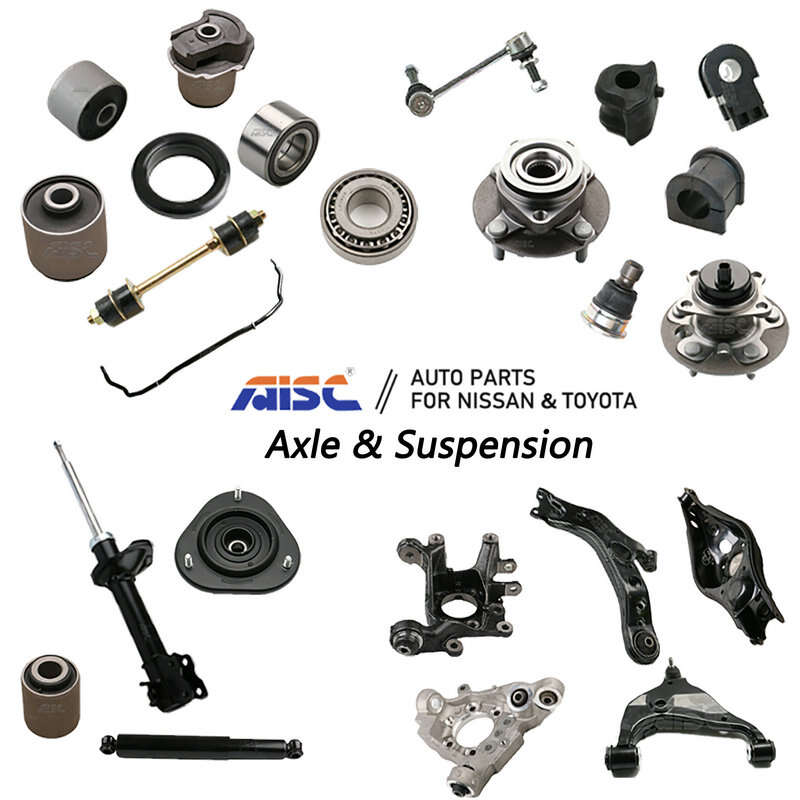Email format error
Email cannot be empty
Email already exists
6-20 characters(letters plus numbers only)
The password is inconsistent
Email format error
Email cannot be empty
Email does not exist
6-20 characters(letters plus numbers only)
The password is inconsistent

News

Understanding Auto Suspension Bushings: Importance, Types, and Selection Guide
The auto suspension bushings play a critical role in the overall performance and comfort of your vehicle. These small yet essential components act as cushions between different suspension parts, absorbing vibrations and impacts from the road. Whether you're a car enthusiast, a mechanic, or just someone looking to maintain your vehicle's suspension system, understanding the function, types, and selection process of auto suspension bushings is key to ensuring a smooth and safe ride.
In this guide, we will explore everything you need to know about auto suspension bushings, including their purpose, the different types available, how to tell if they need replacing, and how to select the right ones for your vehicle.
What Are Auto Suspension Bushings?
At the heart of your vehicle’s suspension system, auto suspension bushings are rubber or polyurethane components that are placed between metal parts, such as the control arm and the frame. These bushings are essential in reducing friction, absorbing shocks, and providing a smooth ride by cushioning the metal components from direct contact with each other.
Without properly functioning bushings, your vehicle’s suspension would suffer from increased wear and tear, resulting in a rougher ride, noise, and reduced handling. The bushings help maintain the alignment and stability of the suspension system by absorbing the force generated during acceleration, braking, and cornering.
Why Are Auto Suspension Bushings Important?
The importance cannot be overstated. They are responsible for:
- Reducing Vibrations: They absorb road vibrations and shocks that could otherwise affect your comfort while driving.
- Enhancing Ride Quality: By reducing the direct contact between metal parts, they ensure a smoother and quieter ride.
- Improving Vehicle Handling: Proper bushings help maintain the alignment of suspension components, which improves handling and stability.
- Minimizing Wear and Tear: By providing a cushion between metal parts, the bushings prevent excessive wear that could lead to expensive repairs.
- Ensuring Safety: Without properly functioning bushings, the suspension system may lose its effectiveness, leading to compromised vehicle control and safety.
Types of Auto Suspension Bushings
Auto suspension bushings come in a variety of materials, each offering unique benefits. The most common types include:
1. Rubber Bushings
Traditional bushings are made from rubber, a material known for its durability and flexibility. Rubber bushings are great for absorbing vibrations and providing a comfortable ride. However, they may wear out faster compared to other materials, especially in vehicles exposed to harsh weather conditions or rough driving.
2. Polyurethane Bushings
Polyurethane bushings are a more durable alternative to rubber. They offer better performance, especially in high-performance vehicles or those used in off-road conditions. While they are stiffer and can transfer more road noise, bushings made of polyurethane last longer and provide enhanced handling and stability.
3. Nylon Bushings
Nylon bushings are often used in performance-oriented vehicles where precision handling is critical. These bushings provide excellent durability and minimal deflection, ensuring a responsive and rigid suspension system. However, they are not as effective in absorbing shocks as rubber or polyurethane.
4. Delrin Bushings
Delrin is a type of plastic known for its high strength and resistance to wear. The bushings made of Delrin offer superior handling, but like nylon, they tend to transmit more road noise and are less forgiving when it comes to ride comfort.
Signs That Your Auto Suspension Bushings Need Replacing
Over time, auto suspension bushings will wear out due to constant stress and exposure to the elements. It’s crucial to know the signs that your bushings need replacing to avoid further damage to the suspension system and maintain your vehicle’s handling and comfort. Some common signs include:
- Unusual Noises: If you hear squeaking, clunking, or popping noises when driving, especially when going over bumps or making turns, your bushings may be worn out.
- Poor Handling: If your vehicle feels loose or unstable while driving, it could be a sign that the suspension bushings are no longer functioning correctly.
- Vibration or Bumpy Ride: Excessive road vibration or a bumpy ride could indicate that the bushings are not absorbing impacts effectively.
- Uneven Tire Wear: Worn-out bushings can cause misalignment, leading to uneven tire wear.
- Visible Damage: Inspect your suspension system for cracks, tears, or any visible damage to the bushings. If any are found, it’s time for a replacement.
How to Choose the Right Auto Suspension Bushings
Choosing the right auto suspension bushings for your vehicle is essential for achieving the best balance of comfort, handling, and durability. Here are a few tips for selecting the right bushings:
-
Consider the Material: Depending on your driving style and needs, choose between rubber, polyurethane, nylon, or Delrin. For everyday driving, rubber or polyurethane is often the best option. For high-performance or off-road vehicles, polyurethane or Delrin may be more suitable.
-
Match the Bushing to Your Vehicle: Make sure the bushings you choose are compatible with your vehicle’s make, model, and suspension type. Refer to the vehicle’s manual or consult with a mechanic if you’re unsure.
-
Check for OEM vs Aftermarket: Original Equipment Manufacturer (OEM) bushings are designed to meet your vehicle’s exact specifications. Aftermarket bushings may offer improved performance but could change the ride quality. Make sure to balance performance and comfort according to your preferences.
-
Durability and Performance Needs: If you do a lot of off-roading or drive in extreme conditions, opt for heavy-duty bushings made from materials like polyurethane or Delrin. For standard driving conditions, rubber bushings should suffice.
-
Professional Installation: Installing bushings can be a complex task that requires specialized tools. It’s recommended to have them installed by a professional to ensure they are properly fitted.
How to Maintain Auto Suspension Bushings
Maintaining auto suspension bushings can extend their lifespan and keep your suspension system in good working order. Here are a few tips for maintaining them:
- Regular Inspections: Check the bushings periodically for signs of wear or damage. Look for cracks, tears, or discoloration.
- Cleaning: Clean the bushings with water and a mild detergent to remove dirt and debris. Avoid using harsh chemicals that could degrade the material.
- Lubrication: Some bushings, particularly polyurethane ones, may benefit from occasional lubrication to maintain flexibility and reduce wear.
- Avoid Harsh Conditions: If possible, avoid extreme driving conditions, such as off-roading or driving through deep water, that can accelerate wear on the bushings.

Conclusion
The auto suspension bushings are often overlooked but incredibly important components of your vehicle’s suspension system. They help improve ride comfort, enhance vehicle handling, and extend the life of other suspension parts. Whether you’re replacing worn-out bushings or selecting new ones, understanding their types, functions, and maintenance will help you make the best choices for your vehicle.
By following the tips in this guide, you can ensure that your bushings remain in good condition, providing a smooth and safe driving experience for years to come. Always remember to consult with a professional mechanic if you’re unsure about the condition of your bushings or need assistance with installation.

